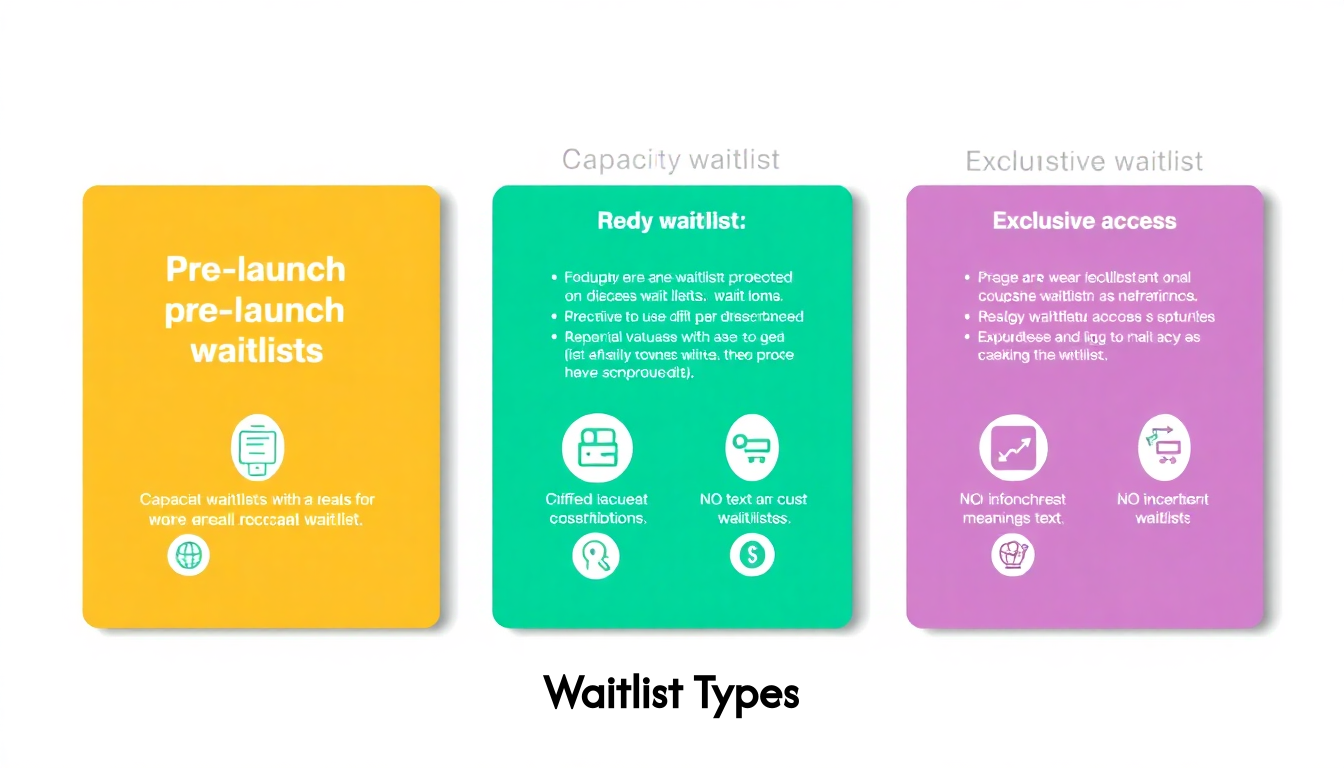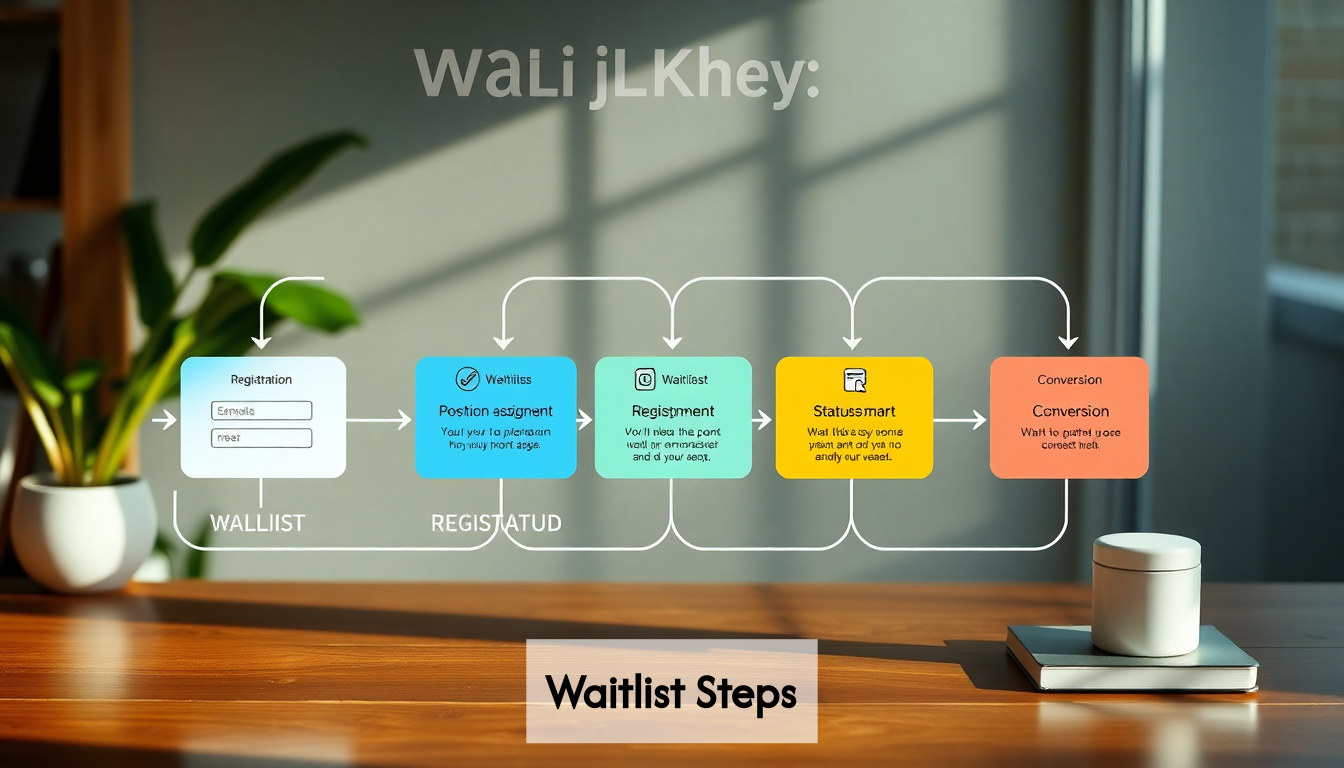Waitlists are taking the business world by storm—over 50% of startups now use them as a crucial strategy for managing customer demand and building excitement. But here’s the catch: many businesses overlook their potential and miss out on maximizing engagement. A well-structured waitlist isn't just about keeping interested users in line; it’s a powerful marketing tool that can influence product development and boost sales. Discover how harnessing the true power of waitlists can transform your approach to customer management and product launches.
What Is a Waitlist?
A waitlist is a systematic way to organize potential customers or users who want access to a product or service that is either temporarily unavailable or not yet launched. Think of it as a digital queue that helps businesses manage demand while building anticipation.

Types of Waitlists
- Pre-launch waitlists: Used before a product is available to generate buzz and gauge interest
- Capacity waitlists: Implemented when demand exceeds supply or available slots
- Exclusive access waitlists: Created to enhance perceived value through limited availability
Waitlists serve multiple strategic purposes beyond simply listing interested people. According to KickoffLabs, a well-managed waitlist helps businesses estimate production needs, especially for physical products or crowdfunded initiatives, while simultaneously building anticipation among potential customers.
Key Components of Effective Waitlists
- Sign-up mechanism: A simple form capturing essential contact information
- Position tracking: Ability for users to see their place in line
- Engagement elements: Features that keep waitlisted users interested and informed
- Conversion system: Process for smoothly transitioning waitlisted users to customers
The meaning of waitlisted status varies slightly depending on context. In business launches, being on the waitlist means you'll be among the first to access a product when available. In educational settings, waitlisted applicants may gain admission if accepted students decline their offers.
Understanding what a waitlist is and how it functions provides the foundation for leveraging this powerful tool for your business growth and customer management strategy.
Key Takeaways
- Waitlists are versatile tools: They can be used to generate interest before launch, manage capacity, or create exclusivity.
- Effective sign-up and communication are crucial: A seamless sign-up process and regular updates are essential for keeping prospective customers engaged.
- Advanced features improve engagement: Priority systems, tiered access, and referral incentives help foster a sense of community and drive conversions.
- Consider potential drawbacks: Long wait times and unclear communication can lead to customer frustration, so businesses should weigh these risks carefully.
How a Waitlist Works
At its core, a waitlist operates as a queue management system that bridges the gap between limited availability and excess demand. Understanding the mechanics behind waitlists helps you navigate them successfully, whether you're managing one or hoping to advance through one.

The Basic Waitlist Process
- Registration phase: Interested parties submit their information to join the waitlist
- Position assignment: Each person receives a place in line, often based on first-come-first-served
- Status updates: Regular communications keep waitlisted individuals informed
- Conversion: When availability opens, people are moved off the waitlist in sequence
Advanced Waitlist Features
Modern waitlists often incorporate sophisticated features to enhance engagement and effectiveness:
- Priority systems: Some waitlists allow participants to improve their position through specific actions. As noted by Dr. Jamie Wilkey on LinkedIn, businesses use waitlists not just for queuing but also to "build community and understand customer needs" before product development.
- Tiered access: Different segments of the waitlist may receive different levels of access or benefits
- Referral mechanisms: Encouraging waitlisted users to refer others, often with position advancement as incentive
- Data collection: Gathering valuable insights from waitlisted users through surveys or engagement
Waitlist Management From Business Perspective
- Demand forecasting: Gauge interest levels for better inventory planning.
- Communication: Keep users engaged to reduce dropout rates.
- Conversion optimization: Maximize waitlist-to-customer transition for higher revenue.
- Data utilization: Inform product/service improvements for an enhanced offering.
The waiting list or waitlist process varies slightly across industries but follows similar principles whether for restaurant reservations, product launches, or educational institutions. The key difference between a waitlist and waiting list is largely semantic—they refer to the same concept, though "waiting list" is sometimes used in more formal contexts.
Understanding how waitlists function equips you with the knowledge to either create an effective one for your business or successfully navigate one as a consumer.
Benefits and Drawbacks of Waitlists
Waitlists offer powerful advantages for businesses and organizations, but they also come with potential challenges. Understanding both sides helps you determine if implementing a waitlist is the right strategy for your specific situation.
Key Benefits of Waitlists
-
Demand forecasting and validation
- Waitlists provide concrete data about market interest before full launch
- Help determine appropriate inventory levels and production needs
-
Marketing leverage and buzz creation
- Generate anticipation and exclusivity around your offering
- According to TicketingHub, waitlists create a sense of urgency ("fear of missing out" or FOMO), which can attract more customers
-
Revenue protection
- Fill cancellations quickly to minimize lost income
- TicketingHub reports approximately 7% of waitlisted guests ultimately book when a spot opens up
-
Customer data acquisition
- Collect valuable contact information for future marketing initiatives
- Gather insights about customer preferences through waitlist interactions
Potential Drawbacks of Waitlists
-
Customer frustration
- Long wait times can lead to negative experiences
- Unclear communication about waitlist status creates uncertainty
-
Resource requirements
- Proper waitlist management demands staff time and attention
- Systems must be in place to maintain and communicate waitlist status
-
Conversion challenges
- Not all waitlisted prospects convert to paying customers
- Interest may wane during extended waiting periods
-
Ethical considerations
- In service industries like healthcare or education, waitlists raise questions about access fairness
- Organizations must balance business needs with ethical responsibility
When to Use a Waitlist vs. When to Avoid One
-
Ideal for Waitlists:
- Limited-capacity offerings
- High-demand products
- Exclusive memberships
- Beta testing programs
-
Consider Alternatives:
- Readily scalable services
- Low-interest offerings
- Essential services needed urgently
- Highly competitive markets with alternatives
The decision to implement a waitlist or waiting list should align with both your operational capabilities and customer experience goals. While a waitlist can create valuable scarcity and help manage demand, it must be balanced against the risk of losing potential customers who aren't willing to wait.
Understanding the meaning of waitlisted status from your customers' perspective is crucial—they need clear expectations about what being on the waitlist means for their chances of eventually accessing your offering.
Tips to Boost Waitlist Success
Whether you're managing a waitlist for your business or trying to advance through one as a customer, these proven strategies can help maximize success and efficiency.
For Businesses: Managing an Effective Waitlist
-
Create a frictionless signup process
- Keep the initial form short and simple—request only essential information
- Offer multiple signup channels (web, mobile, in-person) to accommodate different preferences
-
Maintain regular communication
- Send automated updates about waitlist position changes
- Share relevant content to keep waitlisted prospects engaged with your brand
-
Implement a transparent system
- Clearly display position numbers and estimated wait times
- Explain how the waitlist progression works so customers understand the process
-
Incentivize patience and referrals
- Offer special bonuses for those who remain on the waitlist
- Create referral programs that allow users to improve their position by bringing others to the waitlist
For Individuals: Getting Off a Waitlist Faster
-
Respond promptly to communications
- According to Elite Scholar Advising, many organizations monitor communication engagement, so opening and responding to all emails promptly is crucial
- Set up notifications for communications from the organization
-
Express genuine interest
- When appropriate, communicate your continued interest in the product or service
- Be specific about why you're excited about the offering
-
Provide updated information
- If your circumstances have changed in ways that might prioritize your position, update the organization
- For academic waitlists, share new achievements or qualifications
-
Follow waitlist rules precisely
- Adhere to all guidelines about communication frequency and methods
- Avoid excessive contact that might negatively impact your standing
Measuring Waitlist Effectiveness
For businesses, tracking these key metrics helps optimize waitlist performance:
- Conversion rate: Percentage of waitlisted users who convert to customers — Target: 5-15%
- Dropout rate: Percentage of users who leave the waitlist — Target: Below 30%
- Referral generation: Number of new signups from waitlisted referrals — Target: 0.5+ per user
- Engagement rate: Percentage of users who open waitlist communications — Target: Above 40%
The definition of waitlist success varies by context, but the fundamental principles remain consistent: maintain engagement, provide value even during the waiting period, and create clear pathways for advancement through the queue.
By implementing these strategies, both businesses and individuals can transform the waiting list or waitlist from a simple queue into a powerful tool for relationship building and conversion optimization.
Frequently Asked Questions
What is a waitlist?
A waitlist is a systematic way to organize interested customers or users who want access to a product or service that is temporarily unavailable or not yet launched.
How does a waitlist work?
A waitlist operates as a queue management system where individuals register to join, are assigned a position in line, receive status updates, and are converted to customers when availability opens up.
What are the benefits of using a waitlist?
Using a waitlist helps with demand forecasting, creates marketing buzz, protects revenue by quickly filling cancellations, and allows businesses to collect valuable customer data.
What challenges might arise from having a waitlist?
Potential challenges include customer frustration due to long wait times, resource demands for effective management, conversion difficulties, and ethical considerations regarding fairness in access.
Transform Your Waitlist Into a Growth Engine with WaitKit
Feeling the pressure of managing customer demand as you prepare to launch? If your business is aiming to harness the power of a waitlist for product launches, you may face challenges like unsure customer engagement and long wait times that frustrate potential users. In the article "Waitlist Explained: Your Simple Guide to Success," it's clear that a well-managed waitlist does more than just queue interested customers—it builds anticipation and boosts conversions.
With WaitKit, you can optimize your pre-launch phase like never before. Our innovative SaaS platform transforms mundane signup forms into dynamic waitlists designed to drive viral growth. By leveraging features such as a robust referral system, comprehensive analytics, and automated user engagement, WaitKit turns your waitlist into an engagement powerhouse. Imagine harnessing referral incentives that allow users to climb the waitlist while sharing your product with their friends—creating a self-reinforcing growth loop that builds excitement before the big reveal!
👉 Don't just wait; act now! Start building your viral waitlist with WaitKit today and set your product launch up for unparalleled success. Visit https://waitkit.app to empower your countdown to launch!